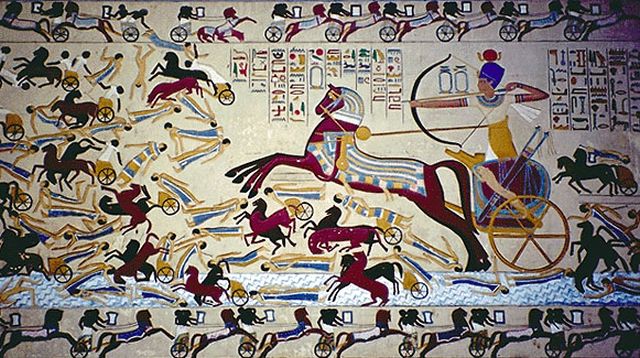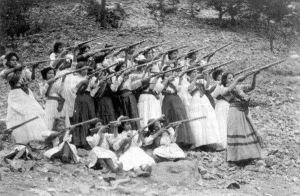Archaeologists have discovered that, at the beginning of the MB II B period (Bronze Age between 1750-1650 B.C.E.), a new form of warrior enter Palestine from the East and went all the way south into Egypt. The Egyptians gave these people the name of Hyksos, meaning conquerors of foreign lands or Shepherd Kings. They ruled an empire that contained Egypt and the territories that surrounded it. When the Hyksos took control over the territory, they tried to destroy all the monuments, kill every native person, and erase Egyptian beliefs into theirs, starting a new era in Egypt.1

Archaeologists describe the Hyksos as a group identified as multi-ethnic that come from West Asia. The Hyksos conquered the Nile Delta and the rest of Egypt. At that time, Egypt was divided into two major regions, Lower Egypt, which was North Egypt, and Upper Egypt which was South Egypt.2 The Hyksos took control over Egypt with a massive army made up of foreign warriors that had no mercy for their enemies. They destroyed everything that got in their way: cities, temples, and houses; and they overran the lands as well. The Hyksos were successful with their attacks. They revolutionized methods of warfare. The Hyksos modified their bows to be more precise and deadly, as well as modifying arrowheads, daggers, swords, and shields. Most importantly, they used the horse war chariot, which made them famous and caused fear among the Egyptians.3 The Hyksos used several cities for different purposes, and all of them equally important. Memphis was the actual capital of the Hyksos. The city of Avaris was a camp located in Lower Egypt, where the government was located. Immense walls were built around the city to fortify it. These walls were forty-five feet high and six feet wide; these walls still exist today. Heliopolis was a city built dedicated for religious purposes only.4
Salatis was the name of the first Hyksos king to rule Upper and Lower Egypt. After conquering both parts of Egypt, he fortified the eastern frontier. Salatis was scared of the Assyrians. They were a group of people who were growing in power and were causing some fear to the kingdom of Salatis. After Salatis died, three dynasties of Hyksos followed him. The last to ruled the Hyksos was a man named Joseph. At the end of Joseph’s reign, the Thebans declared their independence from the Hyksos kingdom. The Thebans were a group of people that had some control over Upper Egypt and who did not like the way the Hyksos ruled. After the Thebans won the war, they decided to expel all the Hyksos from the lands of Egypt, making the Hyksos just another falling kingdom.5
- William Stevenson Smith, “Review of The Rise and Fall of the Middle Kingdom in Thebes,” American Journal of Archaeology vol. 52 no. 2 (1948): 305. ↵
- Carol A. Redmount, “Ethnicity, pottery, and the Hyksos at Tell El-Maskhuta in the Egyptian Delta,” Biblical Archaeologist 58, no. 4 (1995): 182. ↵
- William J. Murnane, “The Second Stela of Kamose and His Struggle against the Hyksos Ruler and His Capital Labib Habachi,” Journal Of Near Eastern Studies 37, no. 3 (1978): 277. ↵
- William H. Stiebing, “Hyksos burials in Palestine: a review of the evidence,” Journal Of Near Eastern Studies no. 2 (1971): 110-13. ↵
- William Stevenson Smith, “Review of The Rise and Fall of the Middle Kingdom in Thebes,” American Journal of Archaeology vol. 52 no. 2 (1948): 306. ↵



28 comments
Nicholas Robitille
I had never heard of the Hyksos before this article and was surprised at their historical relevance. One would think that a group that conquered all of Egypt and made a huge impact on Egyptian culture would be mentioned as more than a footnote in history. I do wonder if the Hyksos’ practice of destroying the culture of the nations it defeated didn’t lead to more discontent from surrounding nations, leading to a faster death of their empire. Overall, this article did an alright job of explaining the practices of the Hyksos.
Ryan Estes
I always love reading about Egyptian history. One of the things I found puzzling about this article is how Lower Egypt is called North Egypt and Upper Egypt is called South Egypt. I thought Lower Egypt would be called South Egypt and Upper Egypt would be called North Egypt. Another thing I found interesting about this article was how the Hyksos seemed to rule Egypt for a relatively short period of time. After Salatis died, only three dynasties of Hyksos followed him.
Diego Terrazas
I did not know so little was known about the Hyksos. I wonder if we will find out more about them in the future. The Hyksos were definitely revolutionary when it came to warfare. They understood the advantages of better weaponry and mobility. Perhaps the huge walls they built worked well against attacks, considering how an inner rebellion overthrew their reign.
Ruby Wynn
I enjoyed reading this article. There are not many articles that I have read on Egypt in the Old Kingdom. I didn’t know that the Hyksos were responsible for many of the more well-known Egyptian cities. It is disappointing that there is not more information on the Hyksos. I am curious about who they are, especially since they conquered so much of the world and were on of the first civilizations to invade Egypt.
John Smith
The Hykos are another interesting group of conquers who tried to establish themselves in the middle east. What I really enjoy learning about each conquer is how they treated the people they conquered, and in my opinion, it was how the Hykos treated the native Egyptians of the time that to their downfall. They may have had martial prowess, but war can only do so much to keep an empire afloat.
Eric Ortega Rodriguez
This was truly a very informative article. I have heard of the Hyksos mentioned before but I liked how they were described in this article. I found it fascinating how they used horse war chariot which allowed them to have recognition among other groups of people, allowing them to have a fear among the Egyptians. Overall, I really enjoyed this article because it was entertaining to read and kept the audience engaged. Very good image selection as well.
Noah Bolhuis
I enjoyed reading this article. I have always had a deep fascination with the ancient Egyptians, and learning about the people that conquered them is just as interesting to me. I had not read or known much about the Hyksos, but they seemed to fit the profile of an ancient conquering people. Killing and destroying everything is an interesting strategy, and it seemed to be effective in their conquest. The walls they built were extremely large and seemed to defend their cities extremely well.
Annissa Noblejas
The Hyksos followed a script typical of conqueror warriors; invading, killing, and erasing the previous belief system. What stepped beyond this routine was their revolutionary modifications of their weapons and how that shaped warfare as a whole. The occupation lasted three dynasties until eventually the Hyksos overthrown and expelled back out of Egypt. However, they left a last mark in the form of a fortified city wall that is still visible today.
Natalia Flores
Great job! I never even heard of the Hyksos so this article was very insightful. I wonder if it was another empire from the Middle East or East Asia that was responsible for the invasion. It’s hard to imagine that an army big enough to overthrow and conquer the Egyptian peoples was completely unorganized and not a part of any empire. It’s a shame that much is known of them since they completely changed how wars were fought back then, especially with how they used horse drawn war chariots and changes to the bows, arrows, and knives.
Samuel Ruiz
Very interesting article! The Hyksos seemed to be a very innovative army, with their modifications and strong weapons. I liked the way that the Hyksos had set themselves up in multiple cities and used their strategy to maintaining power. The end of their kingdom was a tragic ending and unfortunate to their legacy. It is nice to know that archeologists are still looking for more evidence of the Hyksos.